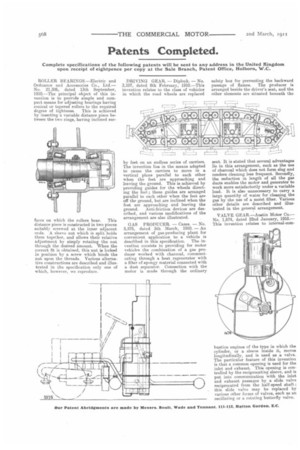Patents Completed.
Page 26

If you've noticed an error in this article please click here to report it so we can fix it.
Complete specifications of the following patents will be sent to any address in the United Kingdom upon receipt of eightpence per copy at the Sale Branch, Patent Office, Holborn, W.C.
ROLLER BEARINGS.—Electric and Ordnance and Accessories Co., Ltd.— No. 21,306, dated 13th September, 1910.—The principal object of this invention is to provide simple and compact means for adjusting bearings having conical or tapered rollers to the required degree of tightness. This is achieved by inserting a variable distance piece between the two rings, having inclined sue
faces on which the rollers bear. This distance piece is constructed in two pieces suitably screwed at the inner adjacent ends. A sleeve nut which is split, holds them together, and allows their relative adjustment by simply rotating the nut through the desired amount. When the correct fit is obtained, this nut is locked in position by a screw which binds the nut upon the threads. Various alternative constructions are described and illustrated in the specification only one of which, however, we reproduce.
DRIVING GEAR. — Diplock. — No. 3,107, dated 8th February, 1910.—This invention relates to the class of vehicles in which the road wheels are replaced
by feet on an endless series of carriers. The invention lies in the means adapted to cause the carriers to move in a vertical plane parallel to each other when the feet are approaching and leaving the ground. This is achieved by providing guides for the wheels directing the feet.; these guides are arranged parallel to each other when the feet are off the ground, but are inclined when the -feet are approaching and leaving the ground. Anti-friction devices are described, and various modifications of the arrangement are also illustrated.
GAS PRODUCER. — Cazes. — No. 5,575, dated 5th March, 1910. — An arrangement of gas-producing plant for convenient application to a vehicle is
described in this specification. The invention consists in providing for motor vehicles the combination of a gas producer worked with charcoal, communicating through a heat regenerator with a filter of spongy material connected with a dust separator. Connection with the motor is made through the ordinary
safety box for preventing the backward passage of flames. The producer is arranged beside the driver's seat, and the other elements are situated beneath the
seat. It is stated that several advantages lie in this arrangement, such as the use of charcoal which does not form slag and renders cleaning less frequent. Secondly, the reduction in length of all the gas ducts enables the motor and generator to work more satisfactorily under a variable load. It is also unnecessary to carry a large quantity of water for cleaning the gas by the use of a moist filter. Various other details are described and illustrated in the general arrangement.
VALVE GEAR.—Austin Motor Co.— No. 1,674, dated 22nd January, 1910.— This invention zelates to internal-com bustion engines of the type in which the cylinder, or a sleeve inside it, moves longitudinally, and is used as a valve. The particular feature of this invention is that a common opening is used for the inlet and exhaust. This opening is controlled by the reciprocating sleeve, and is put into communication with the inlet and exhaust passages by a slide valve reciprocated from the half-speed shaft; this slide valve may be replaced by various other forms of valves, such as an oscillating or a rotating butterfly valve.


























